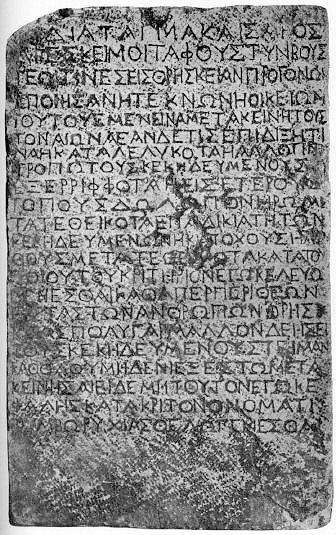Evidence of the Resurrection found in Decree of Caesar
Citations are taken from the link below. Click the link at the bottom to go to a website where the full article is available for viewing.
The following excerpts are a translation of the "Nazareth Inscription," plus a short explanation of how linguistic cues can be used to determine the date at which an ancient document may have been first written.
This is all very exciting. This inscription gives indirect evidence of the claim circulated by the Jewish and Roman authorities that Jesus' disciples had stolen the body, which was given to explain the missing body and counter the claim of the Resurrection.
------------------------------------------------------------
1. EDICT OF CAESAR
2. It is my decision [concerning] graves and tombs—whoever has made
3. them for the religious observances of parents, or children, or household
4. members—that these remain undisturbed forever. But if anyone legally
5. charges that another person has destroyed, or has in any manner extracted
6. those who have been buried, or has moved with wicked intent those who
7. have been buried to other places, committing a crime against them, or has
8. moved sepulcher-sealing stones, against such a person I order that a
9. judicial tribunal be created, just as [is done] concerning the gods in
10. human religious observances, even more so will it be obligatory to treat
11. with honor those who have been entombed. You are absolutely not to
12. allow anyone to move [those who have been entombed]. But if
13. [someone does], I wish that [violator] to suffer capital punishment under
14. the title of tomb-breaker.

"
The Greek word which I translate as ‘title’ in line 14 is onomati or ‘name’. I believe that the word onoma or ‘name’ was an early Greek substitution for the Latin word titulus. The word titulus was used in Latin for the written accusation posted at the site where a condemned person was to be executed. See for example the titulus: “Jesus of Nazareth, King of the Jews,” which was posted over Christ’s head at His crucifixion.
The Roman practice of posting a titulus at an execution site was foreign to the Greek-speaking half of the Roman world, and there was no equivalent Greek word to translate the Latin word titulus. This can even be seen in all three of the synoptic Gospels in the New Testament, where the Greek words aitia (‘legal charge’) and variants of the verb grapho (‘write’) are used together to describe the titulus of Christ, see Matt. 27:27, Mark 15:26, Luke 23:38. However, by the time that the Apostle John wrote his gospel, the Latin word titulus had become a loan word in the Greek language in the form titlos. John 19:19 uses the word titlos for the written charge placed over the head of Christ. The fact that the Nazareth Inscription uses the Greek word onoma or ‘name’ and does not use the later Latin loan word titlos strongly suggests that the Nazareth Inscription was written sometime before the Apostle John wrote his Gospel in the late first century AD."





